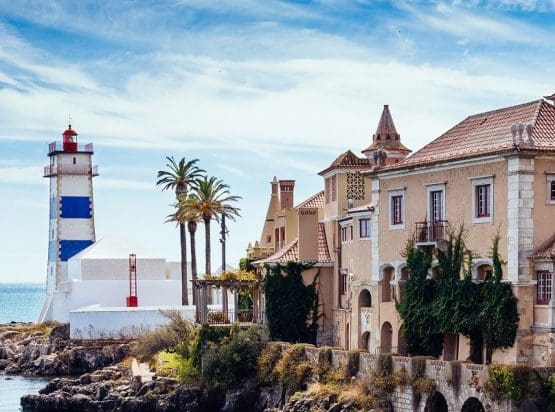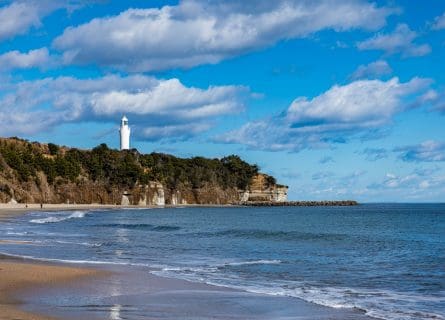Uncover Cascais's vibrant flavors and culinary gems with our expert guides. Plan an unforgettable trip now!
Read more
EXPLORE ALL OUR GUIDES TO PORTUGAL'S WINE REGIONS
Last updated: December 9, 2023
After centuries of proud tradition, Carcavelos finds itself in limbo. In the 1900s, urban sprawl along the west coast of Lisbon reduced the vineyards of Carcavelos to a shadow of their former glory; the building of seafront condos equals grubbed-up vines! As a result, the appellation has become a ‘micro DOC,’ producing a tiny volume of fortified wine – sweet and dry – that resembles honeyed Madeira. And so Carcavelos has a very difficult status indeed. On the one hand, very few, if any, globe-trotting oenophiles have heard of the style; on the other, the region has seemingly been rescued from extinction by younger winemakers who wish to keep alive a cherished part of Lisbon’s viticultural history. The question is: can enthusiasm and passion realistically hold off the property developers? Only time, as they say, will tell.
The hinterland near the capital Lisboa was once a major wine producer of international renown. The Phoenicians and Greeks planted vines, followed by the Romans in 216 BC. The Roman Empire endured for centuries, encompassing most of Western Europe, including the Iberian Peninsula (modern-day Spain and Portugal). Producing a sweet and strong style of wine everywhere they went, the Romans greatly believed in ‘adulterating’ fermented grape juice with sugar, seawater, and herbs. These pungent concoctions were heated over flames for several days, creating a caramelized precursor to Madeira. One can only imagine what these ancient wines tasted like! Some of us would rather not think about it.
Yet Rome’s hegemony over the lives of Portugal’s citizens could not last. Decadence, political mismanagement, and arrogance led to the collapse of the Western Roman Empire in 476 AD. Some may have welcomed this disintegration in the spirit of schadenfreude; however, what followed the Romans was arguably worse. A succession of bellicose civilizations – Alans, Vandals, and Sumerians – invaded the peninsula, wreaking havoc. Yet they could not find the strength to build a stable political presence in this part of Europe. The Suebi, a tribe from northern Europe, fared slightly better – the Suebi controlled northern Portugal until 585. But they were defeated by the Visigoths in the late-6th century, who fortified Ulishbona (Lisbon) against further attack. Nevertheless, the Visigoths were no match for the disciplined armies who arrived in southern Spain via North Africa in 711. The era of the Moors had arrived.
Like the Romans, these conquerors from Africa and the Middle East transformed Portugal’s cultural and social framework, making significant advancements in astronomy, medicine, farming, and architecture. Only during the 11th century did Spain’s Christian monarchs seriously threaten Moorish hegemony. After retaking Lisbon in 1147, Afonso Henriques traveled south to the vineyards of the Algarve. Thus, after a long hiatus, wine production was again on the menu.
However, the vineyards of Carcavelos achieved notoriety in the 18th century. In the late 1700s, the Marques de Pombal chief minister modernized Portugal’s infrastructure – including its winegrowing industry. For his part, Pombal owned a vast estate in Carcavelos, where increasing volumes of fortified sack (wine) were competing with the Port Wines of the Douro. By the 19th century, Carcavelos was the toast of London society, recognized as a demarcated wine zone (Regiao Demarcada) in 1908. Sadly, the encroachment of real estate developers has led to many vineyards being grubbed up over the past few decades. Yet a modest revival is underway.

Carcavelos is at the heart of a region once described as Estremadura or simply ‘Oeste’ (the west). Here, in the vineyards of central Portugal, some of the nation’s most esoteric wine styles are made. Tourists often overlook the zone in favor of the Douro and Alentejo; however, there is much to enjoy in the wines of Carcavelos. The small number of remaining vineyards enjoy a hybrid Mediterranean/oceanic climate, with summer heat moderated by the cooling Atlantic breezes that blow in from the west. The terroir, meanwhile, is most promising: calcareous soils offer good drainage and just the right amount of water retention. Overall, this is an excellent place to fashion high-quality ‘licorosos.’ The vines enjoy a privileged position on south-facing slopes with a gentle incline, while two small rivers – Caparide and Maria-nas – provide irrigation water if required.
Creating a superior vinho generoso (a fortified wine) tests a winemaker’s skill, experience, and patience. Indeed, unlike the production of unoaked whites (Kiwi Sauvignon Blanc can hit the market less than 14 months after the harvest), great fortified wine is aged for many years before it is released. Such is the magic of this sorely underrated wine style: you’re literally drinking the past. According to the DOC (Denominação de Origem Controlada) framework, nine grape varieties are permitted in the blend. However, the small number of producers working today usually focus on four to five.
Typically, the white berries will be crushed, pressed, and then fermented in stainless steel or concrete tanks. Red grapes, meanwhile, will be pressed after the vinification has occurred. However, approaches to fortification with grape spirit vary – certain producers elect to stop the fermentation before all the sugar is converted to alcohol. Others prefer to ferment dry, only adding the vinho abafado (sweet must and neutral spirit) during the blending stage.
The result is a potent blend of sugar, spirit, and wine that must be aged for at least two years in wood before bottling. The alcohol level is normally about 19% abv, with about 80 grams per liter of residual sugar. The finest cuvées, extremely rare today, are matured in barrel for up to 20 years. This slow oxidative aging process is responsible for the awesome complexity and depth that defines a top Carcavelos wine. After a very long and decadent lunch, these are fortified wines to drink with relish.
Any overview of fortified wine usually begins or concludes with a lament that the style needs to be more appreciated by the wine-guzzling public. “How dare they limit their focus to Sauvignon Blanc and Prosecco,” we cry! Twas ever thus: preferences inevitably change over time, and fortified wines are not the height of fashion in Millennial circles. That is unlikely to change anytime soon.
Yet there are clear signs of life emanating from Carcavelos, despite the ongoing pressure to turn every last acre into luxury villas for oligarchs. In 1997, the Municipality of Oeiras and the Ministry of Agriculture joined forces to revive an ancient wine estate: Villa Oeiras. Once owned by the legendary Marques de Pombal, the government hired the brandy specialist Estrela Carvalho and winemaker Pedro Sá to reinvigorate production, using pre-phylloxera vines and a renovated winery. Aging their wines in French and Portuguese oak barrels for at least five years, the modern blends of Villa Oeiras are exceptional. Everything is in balance: sugar, acid, fruit, and alcohol.
Moreover, they can easily compete with the best Port Wines of the Douro. And although it’s still early days, a small (but growing) number of Portuguese consumers are learning to love Carcavelos. Nothing will ever displace dry wine from its throne, but canny oenophiles are learning that variety is the spice of life.
Arinto is a versatile white wine grape variety known for its crisp acidity, citrus, green apple flavors, and a mineral finish
Find out moreBoal is a grape variety grown primarily on the island of Madeira, known for producing rich, medium-sweet wines with flavors of caramel, dried fruit, and nuts. With a deep amber color and a slightly smoky aroma, Boal wines have a smooth, velvety texture and a long, complex finish.
Gallego Dourado is a white grape variety from the Vinho Verde region of Portugal, known for its floral and citrus aromas and crisp, refreshing acidity. With flavors of green apple, lemon, and lime, Gallego Dourado wines are light and easy-drinking, perfect for warm summer days. This versatile grape is often used in blends with other Vinho Verde varieties, and pairs well
Uncover the allure of Periquita grape varietal, a hidden gem in Portugal's wine tradition. Experience new flavors and sensations with this authentic red wine.
Find out moreNegra Mole, also known as Tinta Negra Mole, is a grape variety commonly grown on the island of Madeira, Portugal. It is a versatile grape that can produce a wide range of wine styles, from dry to sweet and fortified.
Tinta Amarela, aka Trincadeira, is a red grape used in Port and red wine. Thrives in dry, hot climates, flaunting purple-skinned allure but susceptible to rot.
Find out moreTrust us: you’ll dine like a prince in the pretty towns and villages that dot the coastline west of Lisbon. Like their Spanish neighbors, the Portuguese take their food and drink very seriously, regardless of the venue. But at heart, most chefs prefer classic recipes and authentic ingredients over hyper-conceptualized cuisine. Of course, Michelin-starred restaurants set their stall on innovation, but the best meals in Portugal are often based on seasonal delicacies cooked with passion and flair. Expect abundant fresh seafood, vegetables grown in market gardens, and delicious steaks. Bacalhau à bras (salt cod, scrambled eggs, fried potato, and marinated olives) is genuinely addictive, particularly with a glass of wine in tow.

Uncover Cascais's vibrant flavors and culinary gems with our expert guides. Plan an unforgettable trip now!
Read more
Uncover Lisbon's vibrant flavors and culinary gems with our expert guides. Plan an unforgettable trip now!
Read more
Uncover Sintra's vibrant flavors and culinary gems with our expert guides. Plan an unforgettable trip now!
Read moreIf you would like us to customize an exclusive luxury tour, contact us and let us know your travel plans. We offer luxury food and wine tours for private groups of a minimum two guests. In addition, all of our private, chauffeured tours are available year-round upon request.

